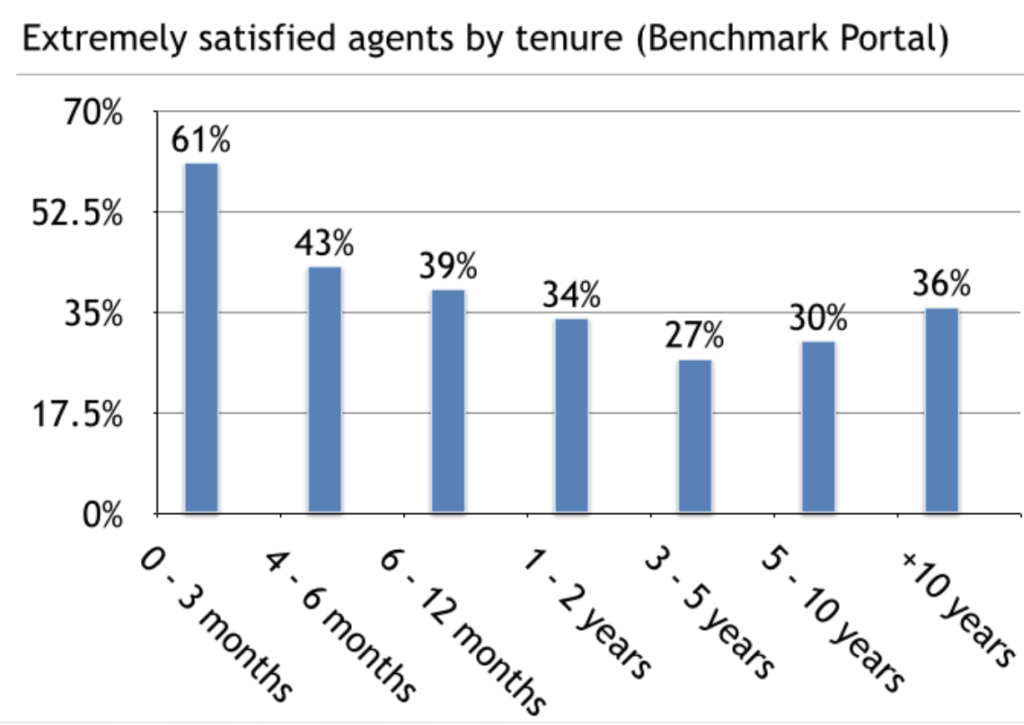This is a guest post from Dhruv Mehta, a Digital Marketing Executive at Acquire.
A lot has been spoken (and documented) about the importance of delivering an extraordinary customer experience. But there is one critical component of the puzzle that is often overlooked—the agent onboarding process.
Come to think of it, the onboarding process for your support agent lays the foundation for a killer customer experience program. After all, the better informed your agents are, the happier your customers will be. If you’re still on-the-fence about the efficacy of onboarding support agents, take a hard look at the data:
- According to Glassdoor, enterprises that have a strong onboarding process can boost new hire retention by 82% and productivity by over 70%.
- As per data, customer service agents are happiest in the first three months of their job or, in other words, typically till the onboarding process lasts:
Needless to say, agent effectiveness and satisfaction are strongly linked with how foolproof your onboarding program is. In this blog, we will look at the top-5 ways to improve your onboarding program and help your new agents kickstart their journey with your company on the right foot.
Related: How to automate your customer support workflows
Top 5 ways to onboard customer support agents effectively
1. Drive initiatives that can build a rapport for new hires as soon as they join the team.
Sure, it is important to acclimatize your new hires to the company policies and core values, but it is equally important to help your new employees build a strong connection with other team members and colleagues right from the start. This could include driving fun activities, interactive workshops and training programs, productive one-on-ones with the senior management, and so on.
For example, in today’s remote work culture, Stack Overflow ensures that every new hire engages in a series of orientation calls with different members of the executive team. Throughout these calls, the new hire gets insights into the company’s history, culture, goals, and structure. In addition to this, the brand encourages the “buddy system,” where a mentor guides the new employee through a six-week onboarding process. Throughout this time, the employee gets to (virtually) meet colleagues from diverse parts of the engineering team to help connect with everyone on a more personal (and professional) level.
As a thumb rule, you should initiate more webinar conferences and video calls (if working remotely) as well as face-to-face meetings and interactions to ensure that the new hire feels a sense of belonging and a strong connection right from day 1.
Related: 5 automations that can help you onboard employees virtually
2. Invest in live chat software and provide in-depth training.
Live chat has emerged as the lifeblood for businesses–be it from the customer’s viewpoint or the employee. When it comes to providing real-time, in-depth training to your agents, investing in live chat software should take priority. Your live chat tool can be used as a ‘learning’ tool for your new agent. It can be integrated with an ‘always-updated’ knowledge base that comprises critical customer-centric as well as business-specific information, such as:
- Company policies, values, and goals so that the agent is on the same page as the company at all times.
- Product or service knowledge, which is continually updated in real-time.
- Training and support workflow, which includes how the agent will handle issue escalation.
- Technical skills and expertise when addressing customer queries.
- Best practices for customer interactions, especially for handling frustrated customers or dealing with customer comments on social media.
In fact, multinational company Dell digitized its onboarding experience by transforming all its onboarding materials in a digital format. The brand uses website, video, chat/IM, webinars, and email throughout the onboarding process:
Interestingly, the company also captures employee feedback in real-time, which has led to significant improvements in the onboarding process:
Another helpful decision you can make is creating customer service videos, which is a great way to both interact with your customers via sending short product tutorials and provide your employees with certain guidance through those training videos.
3. Provide the responsibility of onboarding new talent to an existing experienced agent.
As per research by HCI, 87% of organizations that engage in a buddy program during the onboarding process claim that it effectively speeds up new hire proficiency. Further data reveals that employees who have best friends at work are 7x more likely to be:
- Engaged in their jobs
- Engaged with their customers
- More productive, producing higher quality work
The point we are driving home is this: Assigning a new hire a seasoned buddy/mentor can help speed up the process of onboarding, help agents get hands-on support, and make the process more comfortable and seamless for the new agents. This makes sense because the mentor in question would better understand the new hire’s concerns (as they have gone through the same process) and be able to answer questions with greater empathy as well as context.
Healthcare brand, Hanno, makes an interesting case in point for peer-to-peer mentoring. Not only does the brand have a series of onboarding ‘tracks’ (read: tasks) in Asana to help agents get used to different areas of the company, it also has a solid mentoring program in place. The idea is to help the new hire ‘see’ and navigate all the challenges that they may not be able to preempt or tackle by themselves.
4. Invest in a rock-solid knowledge base.
Onboarding is an ongoing process. Your company is bound to experience new hires ever so often, so why not create an in-depth knowledge base for future use? This knowledge base should essentially:
- From the employee standpoint, it acts as a master document that offers visibility into the company’s core principles and values, success metrics, best-practices, payroll systems, and so on.
- Answer common, FAQ-type questions and queries that the customers may have so that the agents are better informed and can tackle issues within seconds.
If you’re looking for some serious inspiration, take a look at beauty brand L’Oréal’s example. The brand took its onboarding program to the next level by launching a mobile app – “L’Oréal’s Fit Culture” – to assist new hires in understanding, decoding, and mastering the brand’s unique company culture:
The program nicknamed “Life@L’Oréal” offers multilingual support and serves as a “pocket coach” to aid new hires in navigating the L’Oréal culture–a master maneuver if you ask us! It also comes power-packed with data “capsules,” fun challenges, and real-life missions to provide a 360-degree experiential as well as an educative experience for the new hires.
5. Monitor the onboarding progress.
The final and most important component of onboarding is tracking agent progress. If you’re not measuring how your new hire is faring against the tasks and processes set for them, you will never know how effective (or ineffective) your onboarding program is in the first place. So, what metrics can you use to measure program effectiveness? Here are a few examples:
- Measuring the opening rate of onboarding emails
- Monitoring the completion of onboarding tasks set
- Tracking the opening and click-through rates for onboarding content as Slack does–an initiative that led to a 30% decrease in questions from new employees and a successful open rate of 90% on average and above.
Tracking the success of your onboarding program will help you understand how effective it is from the employee’s standpoint and will allow you to make iterations as required along the way.
Wrapping up
In sum, at the heart of agent happiness lies a robust onboarding program–one that can educate, inform, entertain, and engage new hires in a consistent manner. Follow these best-practices outlined above and give your new hires an immersive (and impressive) start as they kickstart their journey with your company.

